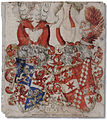Arms of alliance
Appearance

Arms of alliance refers to the heraldic practice of displaying two armorial bearings in their own right side by side, as opposed to impalement or dimidiation. Arms of alliance are acquired either by marriage or taken up by the children of heiresses to show their maternal descent.[1][2][3] Arms of alliance are used almost exclusively by royalty and the nobility, while commoners typically impale the arms of both parties within a single shield.[citation needed]
Gallery
-
Kleiner-Ballsaal)
-
Zimmern-Erbach
-
Dargun-Schloss
-
Gochsheim-Ebersteinwap
-
St. Cyriakus and St. Kilian
See also
References
- ^ Chisholm 1911.
- ^ Clark, Hugh; Wormull, Thomas (1829). An Introduction to Heraldry. H. Washbourne. p. 11. Retrieved 17 January 2019.
- ^ "Definition: arms of alliance". Merriam-Webstar Dictionary. Retrieved 17 January 2019.
(heraldry 1) arms taken up by the issue of heiresses to show their maternal descent. (heraldry 2) arms acquired by marriage
- Attribution
- This article incorporates text from a publication now in the public domain: Chisholm, Hugh, ed. (1911). "Heraldry". Encyclopædia Britannica. Vol. 13 (11th ed.). Cambridge University Press.





